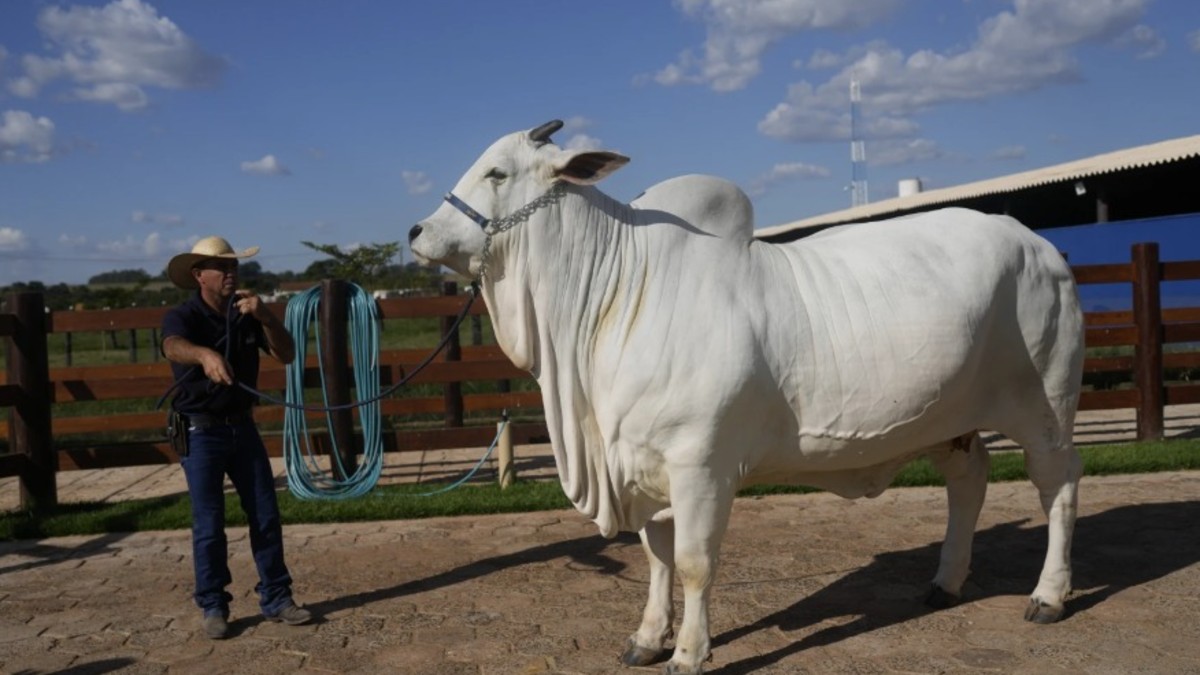There are hundreds of millions of cows in Brazil, yet one stands out.
A veterinarian, and security cameras keep watch over her enormous, snow-white physique.
According to media reports, a Nelore cow named Viatina-19 just broke the Guinness World Record when she sold for Rs 40 crore at an auction.
Here’s all we know about it.
Also read: What is the new vaccine for cow burps? Why is it needed?
The world’s most expensive cow
Worth Rs 40 crore, Viatina-19 is the most expensive cow ever sold at auction in Minas Gerais, Brazil.
According to the reports, the cow weighed 1,101 kilogrammes, which is twice the average weight of any other cow in the same breed.
The distinctive physical traits of Viatina-19, a purebred Nelore cow, include her attractive white fur, loose skin, and noticeable hump on her shoulders. These characteristics are essential to her capacity to adapt to hot temperatures in addition to being aesthetically beautiful.
Viatina-19 won award after award — including “Miss South America” at the Fort Worth, Texas-based “Champion of the World” competition, a bovine version of Miss Universe where cows and bulls from different countries square off.
The cow’s eye-popping price stems from how quickly she put on vast amounts of muscle, from her fertility and — crucially — how often she has passed those characteristics to her offspring, said Lorrany Martins, a veterinarian previously told The Associated Press.
“She is the closest to perfection that has been attained so far,” Martins said. “She’s a complete cow, has all the characteristics that all the proprietors are looking for.”
Also read: Narendra Modi’s birthday: How the PM started the tradition of auctioning his mementos, gifts
The breed’s superior traits
Eighty per cent of cows in Brazil are Zebus, a subspecies that originated in India and is distinguished by its hump and dewlap, or folds of draping neck skin.
Viatina-19 is part of the Nelore breed, also referred to as Ongole cow and originates from India. It was introduced to Brazil in the 1800s.
The breed, identified by the prominent “hump,” is raised for meat, not milk, and makes up most of Brazil’s stock.
These cattle’s strong muscular build, efficient heat tolerance, illness resistance, and efficient grazing habits make them extremely valuable.
Nelore cattle are now a mainstay of the livestock sector, making a substantial contribution to both economic expansion and agricultural output.
The Nelore breed is superior overall because it has a high capacity for reproduction and is expected to produce offspring with superior features. In reality, according to numerous media reports, there is a great demand for Viatina-19 embryos for breeding activities all over the world.
Such cows cost so much that people buy and sell partial ownership
Brazil, along with the US, is at the forefront of cattle genetics; it does more in-vitro fertilizations than any country in the world, João Henrique Moreira Viana, genetic resources and biotechnology researcher at the government’s agricultural research corporation, told AP.
Also read: Why is Poland auctioning its butter reserves?
Ongole cattle
The Aryan people were the first to introduce the Indian Ongole breed, which has a history that predates Christianity by 2,000 years.
This muscular breed came from the Andhra Pradesh district of Prakasam, India, as per The Times of India.
Strong and rough, Ongole cattle are well known for their ability to withstand heat and illness. Consequently, less medical interventions will be used.
Also read: How will taxing cattle’s burps, farts tackle climate change?
Cattle market and climate crisis
Brazilian agriculture was boosted by a resources surge in the 2000s, particularly as China’s demand for beef and soy increased.
Its population of beef cattle is the greatest in the world.
The US Department of Agriculture claims there are currently about 230 million cows.
According to data from Oklahoma State, the nation exports cattle, particularly Nelore, to Argentina, Paraguay, Venezuela, Central America, Mexico, the United States, and numerous other nations.
That is problematic since, according to a World Bank analysis released last year, 86 per cent of the country’s greenhouse emissions are related to its food production, primarily for soy and cattle.
To make pasture, vast tracts of Amazon rainforest have been cut down, releasing carbon contained in trees, and cows emit methane, which is much worse for the climate.
According to Rodrigo Gomes, a beef cattle researcher at the government’s agricultural research agency, lowering the age at which cows are killed is one of the best approaches to reduce livestock emissions. Elite cows can put on weight quickly enough to be slaughtered at a much younger age.
Some argue that genetic advancements are beneficial but constrained means of mitigating global warming.
With inputs from The Associated Press
)